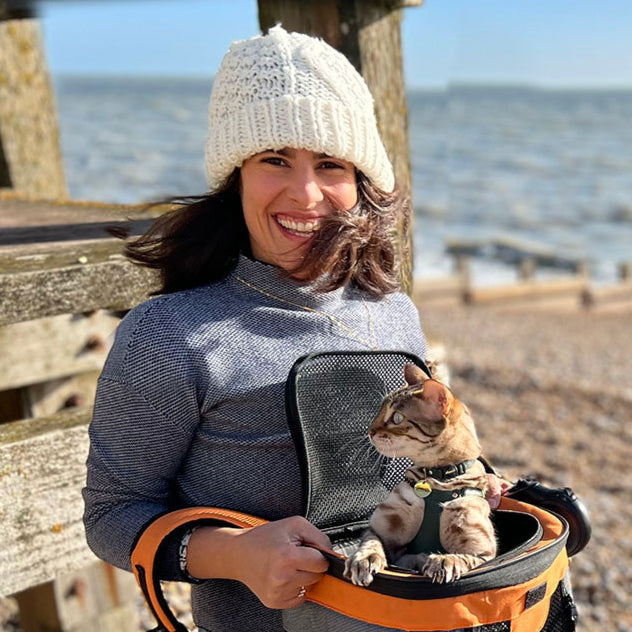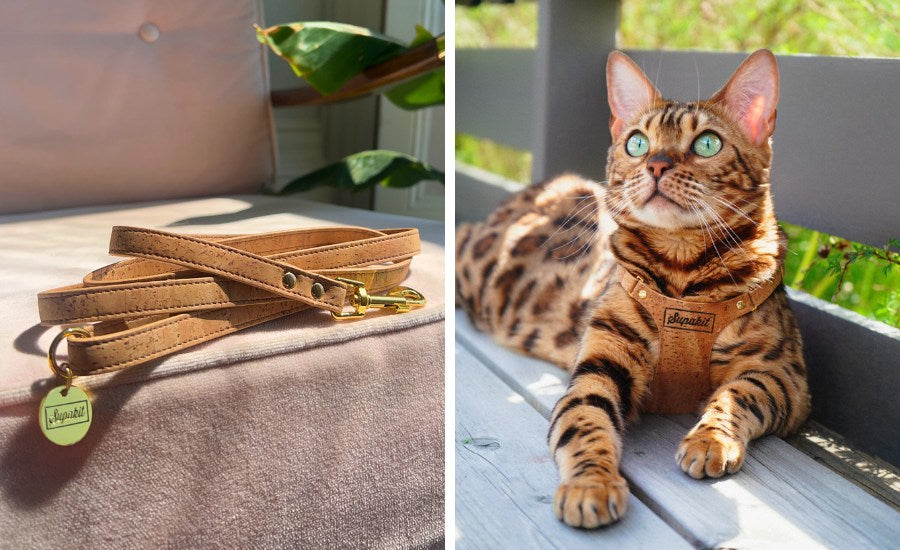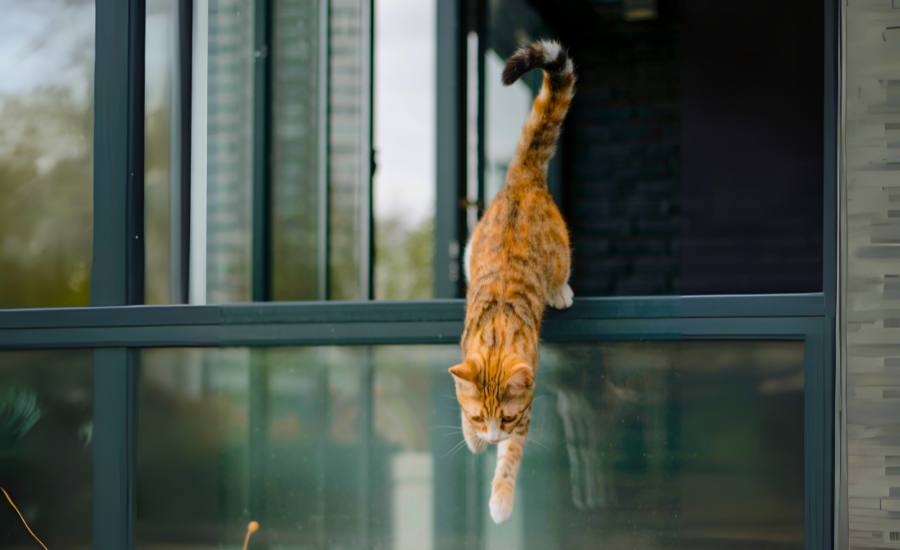How To Keep Your Cat Happy Outside - With Tabitha Kucera
Here at Supakit, we love to get out and about with our kitties. But at the forefront of our minds is how to ensure our cat is happy and calm when exploring outside of the home.
We were lucky enough to speak to Tabitha Kucera from @chirrupsandchatter for November’s #catchat where we discussed ways to keep your cat happy outside of the home, whether that is adventuring on a harness or a trip to the vets.
Meet the expert: Certified Cat Behaviour Consultant and Registered Veterinary Technician - Tabitha Kucera
We were delighted that Tabitha could join us for our latest #catchat but before we dive in, lets learn more about her.
Q: How did you end up being a cat behaviourist?
Tabitha: For as long as I can remember, I have had a strong connection with animals and knew that I wanted to work with them in my professional and personal life. I grew up with cats, dogs, turtles, rabbits and more. In high school, I began to volunteer with local animal shelters and realized I wanted to work with animals as a career. I did some research and came across a veterinary technician, I immediately knew this is what I wanted to do with my life and enrolled into technician school. I graduated from Stautzenberger College and passed my VTNE, becoming a Registered Veterinary Technician in 2010 and still am as passionate about my career as I was when I first enrolled in technician school.
In the first few years of being a technician, I worked at small animal practices, farm sanctuaries and volunteered with various rescues and I realized how many animals were being euthanized due to the misdiagnosis of behavioral issues, misreading of animal body language, and the suffering that animals and humans endured due to them being misunderstood. This is what first got me to become more interested in animal behavior and training.
I then saw the amazing, late Dr. Sophia Yin speak at Midwest veterinary conference and learned that there was a lot I could do as a technician for the issues I was concerned with and was first introduced to Low Stress Handling. I continued to teach myself more about behavior through continuing education, workshops, speaking to experts, completing my Low Stress Handling and Fear Free Certifications, obtaining my KPA-CTP through the Karen Pryor Academy, and became a Certified Cat Behavior Consultant through the IAABC.
I continue to learn from the animals and clients I work with as well as by attending behavior workshops and conferences. I recently completed Living and Learning with Animals: The Fundamental Principles and Procedures of Teaching and Learning with Dr. Susan Friedman and Deep Dive: An Advanced Animal Training Course at the Karen Pryor National Training Center with Ken Ramirez.

Q: What do you love most about what you do?
Tabitha: The best part is helping people better understand and relate to their animals which leads to a stronger bond and a more gratifying relationship between animals and humans. This includes me helping a client with their cat or dog but also working with shelters and veterinary hospitals to have a better understanding of how animals communicate and how we can do all we can to limit the fear, stress, and anxiety of the animals we work with.

Q: What is most challenging about what you do?
Tabitha: The most challenging part is, honestly, seeing all the consequences of people not understanding animals which can often result in people physically and emotionally harming animals and euthanasia. In many cases, these people are not malicious, they have been misled by a “trainer”, by the cultural fog of the media, or misread the animal and situation.Q:What is your number one tip for someone thinking about getting a cat?
Tabitha: Educate yourself. Take your time to learn about your individual cat, be patient and positive with them. Learn about what your cats truly need including meeting both their physical and mental needs.
Related post: 'Ask The Cat Psychologist'
Your #catchat Questions Answered
Q: Do you have any tips for knowing when my cat is enjoying it and when it may be too much?
Tabitha: Great question! I am so happy that someone has asked this. It´s important to be tuned in to your cat´s body language to get a sense of when they may be feeling anxious, for instance if a dog is coming past or there´s something scary. If they’re showing signs of anxiety, I like to have a covered carrier with me that they can go into, or you can distract them with a toy or some high value treats. Not just kibble – the good stuff!
The key thing is to be tuned in early – I think of it light traffic lights green, red and amber. You want to always observe your cats body language and “listen” to them. If you notice subtle anxious behaviours (amber) you want to remove them from what they may be afraid of or change what you are doing (stop petting for example) to prevent them from escalating into the red.
Q: Can you run down some of the really basic signs that tell us a cat’s mood?
Each cat is individual so you need to be aware of what their baseline is. For example, my cat's tail always wags so I know that's normal, but in another cat that could be a sign of anxiety. Some things in general to keep an eye out for as signs of anxiety are…
-
Ears back
-
Your cat's posture drawing in, the longer and more open their body shape is, the more relaxed they are generally feeling. If they're anxious they´ll draw in, becoming smaller.
-
Lip licking
-
Cat looking away, it may just mean that they're uncertain but if it doesn´t resolve after a few seconds that tells me the cat is quite unsure of the situation.
-
Inability to eat or loss of appetite
Q: What should I do when they get really scared by something like a dog or a bicycle coming past?
Tabitha: So I have a stroller – of course I do! And that’s great for if your cat has been spooked by something and you can give them a safe/hiding space to retreat to. Distraction is also really helpful so a toy to draw their attention away from a dog for example.
Q: I have a nervous indoor cat. How best to get her outdoor harness trained without too much stress?”
Tabitha: First thing to say is it’s not for every cat. I have one cat who comes out in the catio with me but doesn’t like to go further. I have one cat who enjoys walks in the park. And there are cats who are more interested in sitting by the window looking out!
The most important thing is to take it really, really gradually. Go at a pace your cat is comfortable with starting at a place your cat is showing minimal to no signs of stress and pairing each step with something your cat enjoys! If your cat is crouching and scared and afraid to move that tells you that you’ve gone too fast. Break it up into tiny baby steps and work at your cat’s pace.
Q: How do you encourage your cat to walk in the direction you wish when out on a leash?
Tabitha: You can use a high value treat to lure them around and turn them from the direction they were heading in. You never want to drag or pull them in a direction they don’t want to go in but if you’re trying to steer them away from something that may scare them then try to lure them away with something that can grab their attention. I’m not talking kibble, but something they really love and rarely have. My cat recently saw a horse for the first time when we were out, so I lured her away with a delicious treat to get increase the distance from the horse and then continued to feed her to pair her looking at the horse with good things.
Q: What are some good indoor activities when it’s far too cold outside?
Tabitha: This is so important!! I’m a big fan of clicker training – it’s a super fun thing you can do with your cat and takes just a few minutes each day. So that’s one. I’m also really into puzzle feeders. I actually don’t feed my cats from bowls, all their meals are enjoyed from puzzle toys. Have a good think about the style of the feeder, it needs to be something that your cat will be into. I like the puzzle toy ones and the foraging mats. Start with an easy toy and increase the challenge based on your cat, www.foodpuzzleforcats.com is a great website to learn more!
You don’t need to spend money to create enriching toys for your cats though! You can use a toilet roll tube and fold it in and hide treats inside. Or a box with lots of paper in it and treats that they can forage out. I’m a big fan of DIY!
Q: When is the best time to start with the leash and outdoors?
Tabitha: It’s good to get into a routine, cats love routine. So if you walk every Thursday night, stick to that pattern. Or if you walk every day head out at the same time. It’s never too late! It’s easier with kittens but my 5 cats are all rescues and not all of them enjoy harness time but for those that do none of them got started under the age of 7.
Related post: 'Cat Walking, Your Questions Answered!'
Q: When we go to the vets Lola is really stressed out. Is there anything we can do before going to get her in a better frame of mind?
Tabitha: I recommend finding a cat friendly/fear free veterinarian to start. Also, as the cat’s caregiver, there is a lot you can do as well. Train your cat to enjoy the carrier. To start, leaving your cats carrier out in the main living spaces as part of the furniture all the time, place catnip, treats, and other things your cats enjoy inside, along with a soft comfy blanket that smells like you. Do low stress travel, playing calming music, covering the carrier with a Feliway infused towel to limit visual stimuli, etc.
Bring your cats favourite treats or toy and bed from home so instead of being examined on a cold metal table, they can be examined on a comfortable, stable, and familiar surface.
Q: How can you help a cat feel relaxed on car journeys if they’re not a huge fan?
Tabitha: If they already have some trauma around the car, you want to break it down into tiny steps. It may also be anxiety around the carrier as well as the car. So you want to try getting your cat happy and comfortable in their carrier at home, and then you might walk with them to the car in their carrier and back. Always hold it with your both your hands underneath, I have no idea why they have handles, you don’t want to take your cat on a rollercoaster ride swinging about!
When you get to the car think about positioning of the carrier. That thing of putting them next to you on the passenger seat and putting your fingers up to them, that’s not ideal. I like in the passenger footwell, covered with a blanket which insulates them from some of the sounds of the car too. So you might do that until your cat is happy in that scenario, then you’d turn the engine on but not go anywhere… and so on. Also, play classical music and make sure the car is at a comfortable temperature, so depending on the time of year either put the heat or AC on beforehand so that its already at a comfortable temperature when you place your cat in.
Q: How can you train your cat if they’re not food motivated?
Tabitha: Well food is a really primary reinforcer meaning food is primary for life , so it’s important to check why your cat isn’t food motivated. I have a lot of clients that say their cats don’t like treats but they like all of the ones I bring! You can’t be using the boring stuff, it needs to be the foods they are crazy about. You may also want to investigate to make sure there aren’t any dental issues, stress, etc. that are influencing their desire to eat. But besides food you can also use play, scent, pets, and more. If your cat enjoys petting, that could work. I have a cat who loves me to rub under his chin so when I’m clicker training with him I’ll click and then give him two rubs under his chin. I am using petting as the reinforcer. The important thing is it’s something they love, and that you do it consistently – click, rub, rub each time.
Q: Do you have any other tips on keeping your cat happy outside?
Tabitha: If you have a kitten, a great way to get them used to sounds, sights and smells is to enrol them in a kitten kindergarten. They’re very much like the puppy parties you’ve heard of but for cats! It’s a fantastic way of introducing them to other cats and getting them used to going out of the house and experiencing other things.
We found our #catchat with Tabitha incredibly insightful and offer a huge thanks for her taking time to chat with us, her advice has been invaluable. We also look forward to welcoming Tabitha back for another #catchat in early 2021! You can check out more from Tabitha on her social channels @chirrupsandchatter and her website: www.chirrupsandchatter.com
Related post: 'How To Keep Your Cat Happy At Home'







